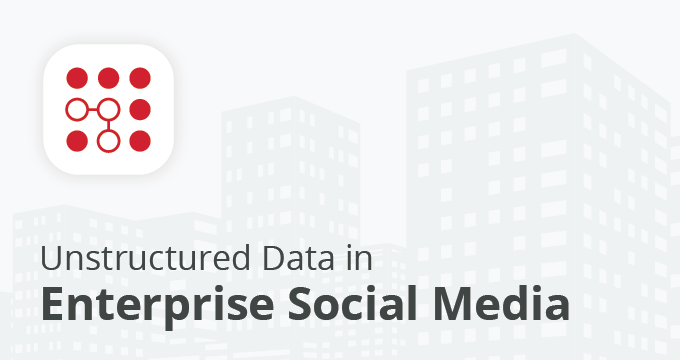Enterprise communication has undergone a seismic shift.
The rise of internal social networks (ESNs) has transformed how employees connect and collaborate, while a staggering 97% of Fortune 500 companies leverage external social media platforms like Facebook, Twitter, YouTube, and even TikTok to connect with customers, build communities, and drive growth.
But here’s the challenge: Just like that’s the case with email and other communication tools, all this social media activity generates a massive amount of unstructured data.
From employee posts on Slack to customer reviews on G2 or Capterra, this data doesn’t fit neatly into rows and columns. And yet, it holds incredible potential for insights that can improve decision-making, customer service, and even product development.
In this post, we’ll discuss:
- What is unstructured data
- The difference between structured and unstructured data
- The benefits of analyzing unstructured data
- Social media and unstructured data
- The challenges of dealing with unstructured data
- Unstructured data management and compliance
- Best practices for handling unstructured data.
What Is Unstructured Data?
Unstructured data refers to information that does not have a pre-defined data model or is not organized in a systematic manner.
This type of data can come in various forms, such as text, images, videos, and more. Unlike structured data, which is neatly stored in databases with specific formats, unstructured data is often scattered and lacks a consistent framework.
Characteristics of unstructured data
- Variety. Unstructured data comes in a number of different formats, including text files, emails, social media posts, videos, and images.
- Volume. It’s typically larger in size compared to structured data.
- Velocity. Unstructured data is generated rapidly and continuously.
- Complexity. Due to its exponential growth and lack of organizational framework, unstructured data is difficult to analyze and requires advanced tools for processing.
The Difference Between Structured and Unstructured Data
The term structured data refers to any data that may be stored in a relational database.
To put it another way, data stored in a relational database management system (RDBMS), the foundation of SQL (Organized Query Language), is, by definition, highly structured. Fields and values are very consistent across database entries, making it quick to search and easy to comprehend the relational structure of the data.
On the other hand, as we’ve already established, unstructured data is defined as data that does not exist in a relational database management system (RDBMS).
It encompasses a wide range of data types, including text documents, PDFs, spreadsheets, presentations, videos, photos, audio, and more.
So, is social media unstructured data?
Yes, social media is unstructured data, along with all of the current workplace communication tools like mobile text messaging or video conferencing platforms.
According to estimates, such data accounts for 80% to 90% of all digital information in the world.
Because of the sheer volume of digital communication that takes place in modern workplaces, organizations have a hard time dealing with the large volumes of data generated by various sources, and managing unstructured data is especially challenging.
The Challenges of Dealing with Unstructured Data
With the growing amounts of data businesses collect, data has become increasingly difficult to manage. Most organizations still rely on relational database management systems (RDBMS) to store their data.
However, these systems are not designed to handle unstructured data.
This means that if unstructured data is needed, it might take a significant amount of time, effort, and financial and human resources to manually extract the data, move it to another system, and then analyze it.
Because these steps are manual, data extraction, transfer, and review are often error-prone, making the process inefficient and inaccurate.
This presents a big challenge for the following:
Ediscovery
Legal teams often struggle when dealing with electronic unstructured data from various sources (email, social media posts, text messages, images) and trying to collect relevant unstructured data during the ediscovery process.
All these records need to be collected, combed through, exported to an acceptable universal format (evidentiary quality), and then reviewed and presented. Apart from taking a lot of time, this process is very cost-intensive.
| Related: Social Media Ediscovery Key Principles |
Data security
Unstructured data presents a new problem in terms of recordkeeping and data security.
The GDPR and CCPA, as well as rising consumer pressure, are making it harder for businesses to handle information responsibly and to respect the privacy of everyone involved.
| Related: GDPR Compliance and Email Archiving – Jatheon |
Compliance
Enterprise social media channels, websites, email, and mobile text messages all need to be tracked to meet regulatory compliance, which can be tough to do in real time, especially for so many data sources.
Companies, especially those in highly regulated industries, need to comply with multiple legal requirements.
In the healthcare industry, for instance, HIPAA requires organizations to protect patient privacy, while financial service companies need to comply with regulations like FINRA and SEC.
The Benefits of Analyzing Unstructured Data
Unstructured data, despite its complexity and challenges, offers numerous benefits that can significantly enhance business operations and decision-making processes.
Here are some key advantages:
Enhanced customer insights
Unstructured data from social media, emails, customer reviews, and support tickets provides a wealth of information about customer preferences, behaviors, and sentiments.
By analyzing this data, businesses can gain deeper insights into what their customers want, identify emerging trends, and tailor their products and services accordingly.
Improved decision-making
The rich, qualitative nature of unstructured data originating from different sources enables organizations to make more informed decisions.
Advanced analytics tools allow businesses to identify meaningful patterns, trends, and correlations from unstructured data, leading to more accurate and effective strategic planning.
Competitive advantage
Organizations that effectively harness unstructured data can stay ahead of their competitors.
By monitoring social media and other unstructured data sources, businesses can quickly identify market opportunities, respond to threats, and adapt to changing market conditions faster than their competitors.
Better customer service
Unstructured data helps businesses enhance their customer service by providing a comprehensive view of customer interactions.
Chat logs, emails, and social media interactions contain a wealth of relevant customer information that can help identify common issues and improve response times, which can lead to higher customer satisfaction.
Employee engagement and satisfaction
Internal unstructured data, such as feedback from employee surveys or discussions on internal social networks, provides insights into employee engagement and satisfaction.
This information can help human resources departments address concerns, improve workplace culture, and retain top talent.
Unstructured Data and Social Media
We’ve already answered the “is social media structured or unstructured data?” question. But what implications does social media unstructured data have for businesses?
When it comes to enterprise social networking, there is a lot of data that has to be managed and this data is both useful and complicated. Enterprise social networks aren’t only conversational tools. They also make it easier to share information and work together.
As a result, companies must carefully assess the legal and data governance implications of any enterprise social network they choose to adopt.
It’s crucial to understand that legal teams have been forced to adapt to the widespread adoption of enterprise social networks and other email alternatives. Legal professionals are used to dealing with documents, not digital communication records.
This means that legal departments must carefully assess how they can treat relevant social media and other unstructured data. Without proper policies, procedures, and technology in place, legal teams might find it challenging to collaborate with other departments, affecting their ability to protect the business.
Related: Social Media Ediscovery and Investigating Employee Misconduct
How to Handle Unstructured Data from Social Media
Social networks are a new, valid and important source of data. To preserve these business records, comply with regulations, and support ediscovery, enterprise social networks must be regulated properly and the adoption by businesses has to be done right.
As workplace social networks replace email and become engines for internal communication and collaboration, companies must properly implement these technologies in order to maintain data security.
Here are five best practices to follow:
- Archive all social media data. Social networking platforms are constantly changing, which makes data archiving all the more important. Social network data must be captured in real-time, archived in an immutable format, fully searchable, and presented in context to facilitate evidence review.
- Develop policies for social media use. Policies and guidelines outline the acceptable and unacceptable uses of social network platforms. Employee training for social media use should be documented and updated regularly, and all activity on the platforms must be documented.
- Implement retention and deletion policies for social media data. All social media data must be captured, archived, and retained. It’s important to note that mandated and recommended social media data retention schedules vary based on industry, company size, and whether you’re actively using social networks for marketing and communications.
- Implement monitoring policies for social media use. Social network monitoring helps companies comply with regulations, ensure data security, and mitigate risk. Monitoring should also be implemented to safeguard intellectual property and confidential information, as well as monitor for harassment, discrimination, and other types of employee misconduct.
- Implement ediscovery policies for social media data. Social media data can be used as evidence in legal cases, so it’s important to implement ediscovery policies, procedures, and tools. Since the digital trail created by social media is often long and complex, legal teams need the ability to quickly find, extract, and act on relevant records.
Summary of the Main Points
- Unstructured data is information lacking a predefined data model, often in the form of text, images, video, spreadsheets, etc., and it comprises 80-90% of all digital data.
- Structured data fits neatly into tables, while unstructured is diverse and harder to organize.
- Social media = unstructured data. Posts, comments, and other interactions are a key source of this valuable but complex data.
- It’s challenging to manage and analyze due to its lack of structure.
- It poses challenges for ediscovery, compliance, and data security.
- The benefits of unstructured data include deeper customer insights, improved decision-making, competitive advantage, enhanced customer service, and increased employee satisfaction.
- Best practices for handling unstructured data include archiving, developing clear usage policies, implementing retention and deletion policies, and establishing ediscovery procedures.
How Jatheon Can Help
Jatheon’s social media archiving software can extract data from multiple social media sources, including Facebook, Twitter, Instagram, YouTube, WhatsApp, etc. It provides legal, HR, and IT professionals with the data they need to perform ediscovery, compliance audits, litigation support, and internal investigations.
The platform’s intuitive interface allows users to easily pinpoint relevant data using precise search criteria, including keywords, specific users, date ranges, and other filters. Additionally, users can streamline their review process by filtering data by file type. Extracted data can be effortlessly exported in a fully searchable, human-readable format, making it readily available for use in reports, presentations, and comprehensive data analysis.
To learn more about how Jatheon can help your company with its unstructured data challenges and social media archiving, book your demo today.
FAQ
What is unstructured data used for?
Unstructured data is used for customer insights, marketing strategies, product development, compliance, and legal discovery, among other applications.
What is an example of unstructured data in social media?
Text posts, comments, images, videos, and hashtags belong to the unstructured data category.
What types of data are pulled from social media?
Posts, status updates, comments, multimedia data, engagement data such as likes or shares, metadata such as timestamps or geolocation, sentiment data, and network data.
How to convert unstructured data to structured data?
It’s possible to use a process that often involves using specialized software tools, natural language processing (NLP) algorithms, and machine learning techniques to identify patterns, extract relevant information, and categorize the data into a structured format.
Read Next:10 Best Email Alternatives for Better Collaboration in 2024 Social Media Ediscovery and Investigating Employee Misconduct |











